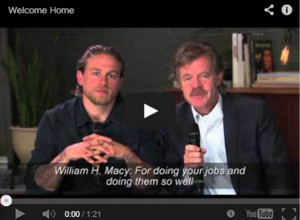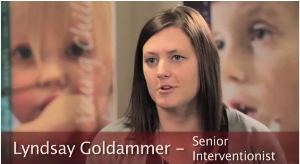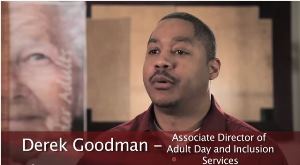by Rachel Talen
I would like to introduce our new Marketing & Corporate Relations intern, Mary. Mary is a senior at Calvin College, where she is studying Strategic Communication.
Vets: We need your skills
by Mary Van Poolen

Easter Seals recently released our “Welcome Home” video which shares our mission of serving veterans and their families with Hollywood. Some of my favorite actors and actresses such as Don Cheadle, Hannah Simone, Hayden Panettiere, Fred Armisen, and Mindy Kaling show their support in the video by welcoming home our military veterans.
As the new Marketing and Corporate Relations intern, I am honored to be a part of such an exciting partnership.
In light of Easter Seals’ newly released video, I had the opportunity to sit down with recent war veteran and employee at Easter Seals headquarters, Christopher Dillon, to hear about and share with you what his own welcome home experience was like after serving in Iraq. Many do not realize that war veterans live and work right in the backyard of Easter Seals headquarters.
Chris grew up in Hayward, WI and lived there his entire life. He decided to join the U.S army in order to support his country and see the world outside of the small town. I asked Chris how the friendships he made in the army were different than his friendships back home. He mentioned that he made close friends and still remains in contact with most of them.
“Friendship in the military takes it a step further than in the civilian world. Your life depends on them and their life depends on you. You’ve experienced a lot of stressful situations together…it’s tighter…it’s closer,” says Chris reflecting on his service.
While in Iraq, Chris served as a combat engineer in Ramadi, Habbaniya and Fallujah.
On July 3, 2003 at 6:45 am Chris’ convoy was struck by a roadside bomb causing injuries that forced him to take a Medevac, an emergency removal flight, back to the United States. I can only imagine what that morning must have been like. There weren’t that many people at his welcome home because he was sent back on a Medevac to Germany and then to Peterson Air Force Base in Colorado Springs, CO, and was taken to a hospital at Fort Carson. Once at Fort Carson he was “attacked” by his two daughters whom he hadn’t seen in over 4 months. “Pretty much what I wanted…I wanted my daughters there,” he says.
After returning home he pays much more attention to detail because of how routine it was for him to check for grenades, wires and roadside bombs. It was difficult for him not to think of a fixed pothole as a roadside bomb and it took a while to remember, “…you’re at home, this is not going to happen here.”
After being medically cleared in September 2003, he received orders that he wouldn’t be returning to his unit in Iraq, but to the United States Military Academy, West Point, as a Company & Battalion Tactical NCO. Nearly three years later, on June 1st, 2006, Chris retired after 23 years of service due to the request of his daughters. Erin, his oldest daughter, told him that she and her sister wanted their daddy back.
I was curious about what brought Chris to Easter Seals and he says that his VA representative told him about the open Training Specialist position. He interviewed, got the job and worked at Easter Seals from 2009-2010 until the Operation Employ Veterans program lost its funding. While unemployed he helped other veterans put together resumes and find work until he realized that it was time to do something for him. He contacted Easter Seals to catch up with a friend and found out the Community OneSource Manager position was open. He was encouraged to apply and within a couple of weeks Chris was able to continue his journey with Easter Seals and Veteran Services.
“There are a lot of skill-sets that I had learned in the military that I took for granted and that I found out are really needed in the civilian world,” says Chris. “One of the hardest parts of my job today is getting veterans to realize that the skills they have are needed.” On behalf of Easter Seals, we thank Chris Dillon for his service, for welcoming home veterans, and for helping them realize their fullest potential in the work force.
If you want to support employment for veterans, here’s a way you can help right now: visit our Honoring Those Who Serve Challenge page on CrowdRise and make a donation, or learn more at www.easterseals.com/veterans.
 Our team at Easter Seals Southeast Wisconsin recently read The End of Fundraising by Jason Saul. The premise of the book is that non-profits need to understand what impact their services have on the community, beyond just numbers served or social good. We reviewed the literature to establish what impact our services have on Southeast Wisconsin. What we learned is with the right services and supports we improve not just the life of one individual, but their family and local employers. We impact taxpayers, too: as an individual’s independence grows, their need of public support decreases.
Our team at Easter Seals Southeast Wisconsin recently read The End of Fundraising by Jason Saul. The premise of the book is that non-profits need to understand what impact their services have on the community, beyond just numbers served or social good. We reviewed the literature to establish what impact our services have on Southeast Wisconsin. What we learned is with the right services and supports we improve not just the life of one individual, but their family and local employers. We impact taxpayers, too: as an individual’s independence grows, their need of public support decreases. So far this blog post has the impact of making you sleepy, so allow me to debut our two impact videos. One video is about autism services, and the other video is about adult day services. Each one features people who are directly touched by our services and their families while also recognizing the impact we make at the community level. I hope you enjoy watching them as much as we enjoyed putting them together. In other words, I hope they make an impact!
So far this blog post has the impact of making you sleepy, so allow me to debut our two impact videos. One video is about autism services, and the other video is about adult day services. Each one features people who are directly touched by our services and their families while also recognizing the impact we make at the community level. I hope you enjoy watching them as much as we enjoyed putting them together. In other words, I hope they make an impact!











